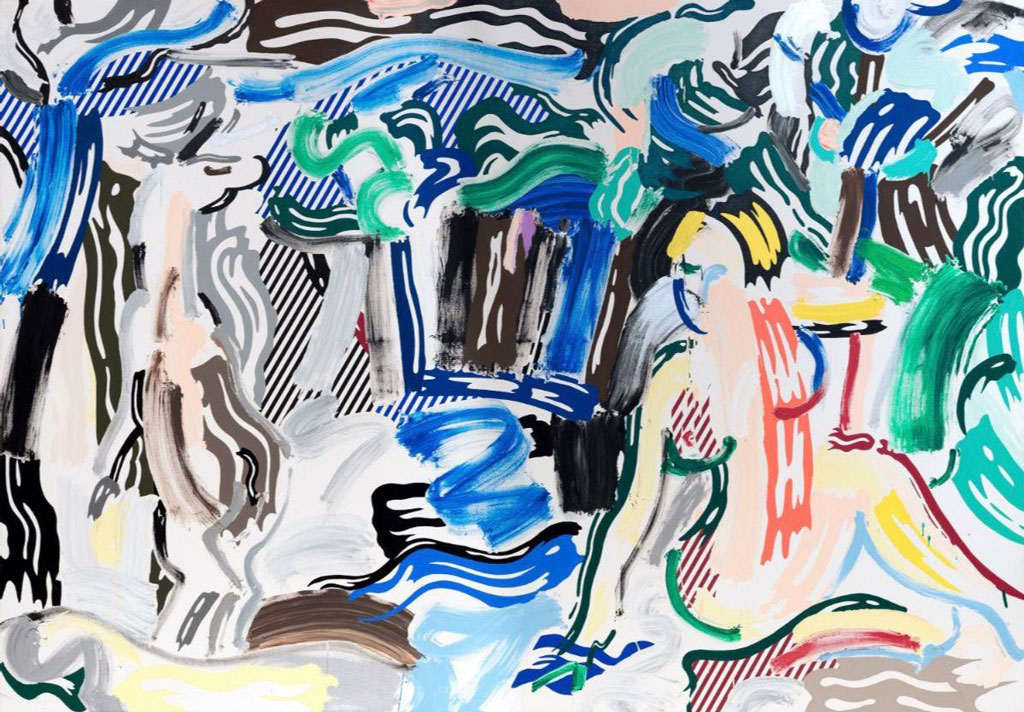ART-PRESENTATION: Roy Lichtenstein-The Loaded Bruch
 By the late 1960s, Roy Lichtenstein had stopped using comic book sources. In the 1970s his focus turned to creating paintings that referred to the art of early 20th century masters like Picasso, Henri Matisse, Fernand Léger and Salvador Dalí. In the 1980s and ’90s, he also painted representations of modern house interiors, brushstrokes and mirror reflections, all in his trademark, cartoon-like style. He also began working in sculpture.
By the late 1960s, Roy Lichtenstein had stopped using comic book sources. In the 1970s his focus turned to creating paintings that referred to the art of early 20th century masters like Picasso, Henri Matisse, Fernand Léger and Salvador Dalí. In the 1980s and ’90s, he also painted representations of modern house interiors, brushstrokes and mirror reflections, all in his trademark, cartoon-like style. He also began working in sculpture.
By Efi Michalarou
Photo: Galerie Thaddaeus Ropac Archive
Titled “The Loaded Brush” the exhibition presents major figurative and abstract paintings, sculptures, collages and drawings by Roy Lichtenstein, the exhibition focuses on Lichtenstein’s innovations of the 1980s, when the artist developed a new visual language based on the form of the painted stroke, reduced to its simplest expression. Through these works Lichtenstein continued to refine and reinterpret the techniques and palette of his iconic Pop style, while engaging with a new subject matter: the brushstrokeform. In the 1980s, Lichtenstein made a systematic examination of the formal properties of brushstrokes through works that depicted the gestural strokes of Expressionist painting using a Pop Art aesthetic: flattening the brushstrokeform by rendering it in bold, unmodulated colours with heavy black outlines. In this way, Lichtenstein denies the brushstroke’s status as an index of artistic labour, instead giving it the appearance of a mechanically produced image whose physicality is inseparable from the pictorial plane of the canvas. Through this treatment of the brushtroke-form, Lichtenstein furthered his investigation of perception and the conceptual complexities inherent in the simple lines and flat forms basic to visual representation. In the same decade, Lichtenstein extended his exploration of the brushstrokeform beyond the two dimensional canvas into the realm of sculpture. The artist composed a number of freestanding, three dimensional brushstroke pieces, which took the form of mediumsized and monumental public sculptures. By translating the fluidity of paint into a permanent, metallic medium, these sculptures parody the gestural style of Expressionism signified by the brushstroke. Consequently, the brushstroke imagery in these sculptures stands as symbols of individual expressive freedom while simultaneously challenging the conventional fetishisation of the artist’s hand and media. In using the subject of painting to move beyond painting, Lichtenstein undertook a radical interrogation of his own artistic medium, subject matter, and style. In so doing, the artist likewise raised new questions regarding the spatial relationship between the viewer and the contextualising environment of each piece. Together, the brushstroke sculptures and paintings constitute a significant portion of the artist’s oeuvre and demonstrate some of the guiding interests of Lichtenstein’s ongoing artistic development across a variety of materials.
Image: Roy Lichtenstein, Artemis and Acteon, 1987. Oil, acrylic on canvas, 213 x 305.4 cm, © Estate of Roy Lichtenstein / Bildrecht Wien, 2019
Info: Galerie Thaddaeus Ropac, Villa Kast, Mirabellplatz 2, Salzburg, Duration: 27/7-28/9/19, Days & Hours: Tue-Fri 10:00-18:00, Sat 10:00-14:00, www.ropac.net
